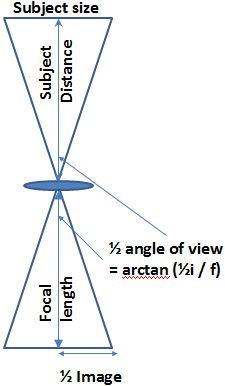Camera lens rules
Because my daughter has been on school holidays this week I have been spending time at home and thinking about photography more than work. In some of the forums I've been reading I keep seeing questions about the "digital SLR crop factor" - and statements that given focal length on digital is equivalent to a lens of 1.5 or 1.6 times the focal length on a 35mm film camera, so I thought I'd put the details down once so I can refer people here :-)
The lens doesn't do different things with rays of light when you mount it on a different body; focal length never changes. However angle of view is a function of focal length and film/sensor size. We can calculate this with the formula 2 arc tan (2*focal length/image size) and you can see how this works in the diagram. It follows that if one camera records an image which is 1.5 times the size of another camera, it needs a lens with 1.5 times the focal length to get the same angle of view. If you look at the Details page of an image's properties in Windows explorer you can often see a 35mm equivalent focal length recorded. The diagram also helps us to understand the relationship between distance to the subject, size of subject and size of image. If you imagine taking photographing a building which is 36M wide so it fills a frame of film which is 36mm wide, the ratio of the building size to the image size is 1000:1. You can see that using similar triangles the ratio of lens to subject and lens to image distances must also be 1000:1 with a 50mm lens we'll be 50M away. If you take the same picture on a digital camera with a 24mm sensor, the ratios are 1500:1, so we'll need be 75M from the building to get it all in the frame. Absolute Image size never changes. A 36m wide subject will always give a 24mm wide image with a 50mm lens 75M away. (The lens won't change what it does). But if the frame size changes, there is a change in the proportion of the frame the image occupies. Now: if changing the camera means a subject which is smaller or further away fills the frame it is natural for some photographers to call this magnification. Others, particularly who deal with Macro ratio (the ratio of subject size to image size) will say this isn't magnification. They will point out the image isn't bigger, it's just had its edges trimmed off, so what's left seems to have been magnified. |
 |
Perspective is not a consequence of focal length or angle of view as such: it only depends on the relative distances between the different objects in the image. If two objects are the same size but one is 1M in front of the other, with the camera 1M from the front object the one in the background 2M from the camera and appears half the size. If the camera is 9M front the front object, the far object is 10M away and appears 90% of the size. But where you position the camera depends on it's field of view so in practice focal length does affect perspective, albeit indirectly - wider angles of view mean you move closer to the foreground and you get a heightened perspective effect.